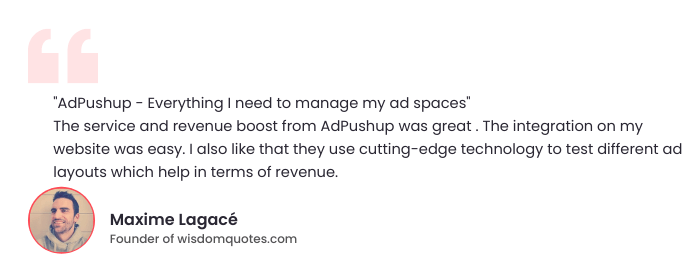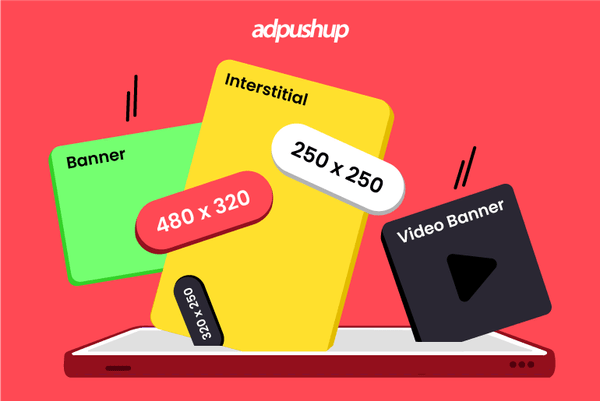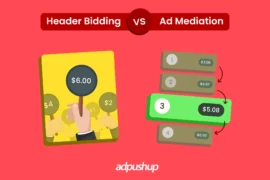In an era where every pixel matters and user experience reigns supreme, mastering the art of ad formats and strategies is not just a choice but a necessity. Since mobile ads are increasingly becoming popular, trying out different mobile ad sizes is essential for publishers trying to achieve the best out of their monetization efforts.
According to a study by Statista, there are 4.66 billion active mobile internet users. That means almost 78% of users appear online daily via mobile web or in-app. This fact inevitably boosts ad growth.
- 29% Of people’s daily screen time is spent looking at smartphones.
- Mobile media time spent is higher at 51% compared to the desktop in the USA.
There are currently 4.68 billion mobile users around the globe. These are users from different geographical locations of various ages and statuses (financial and socioeconomic). This creates a massive pool of users and allows publishers to bring them to their websites and show relevant ads.
Moreover, 70% of world internet usage is on mobile devices. Each individual spends approximately 3 hours 35 minutes on his/her mobile device daily. Therefore, we can infer that mobile advertising is both the present and the future of online advertising.
Now, let’s say you want to give mobile advertising a try. But where to start? What type of ads work on mobile? And what is the best mobile ad size? These are the common questions for every publisher.
Let’s answer these questions once and for all.
What are Mobile Ad Sizes (Mobile Advertising Formats)?
Mobile ad size refers to the dimensions and layout of advertisements designed to be displayed on mobile devices, such as smartphones and tablets. It plays a critical role in the overall effectiveness of a mobile advertising campaign, as the size and format directly impact how well the ad captures user attention and fits within the constraints of mobile screens.
Mobile Ad Spend Statistics
With a steady rise in programmatic advertising in the last few years, the ad spend on mobile advertising has experienced a huge leap. According to eMarketer, US mobile ad spending will have reached $200 billion in 2024 and $230 billion by the end of 2025. As you can see in the graph below, the majority of the mobile ad spending will be spent on in-apps.
Now, let’s look at some of the best mobile ad sizes categorized by ad formats to help publishers pick the right one.
Top 10 Best Mobile Ad Sizes for Increased Viewability

1. In-app Ads
In-app ads are the ads that publishers serve to users within mobile applications. These ads are one of the most popular ways for publishers to monetize their audiences and products, keeping the app free for use.
In-app ads are the ads that publishers serve to users within mobile applications. These ads are one of the most popular ways publishers monetize their audiences and products, keeping the app free.
Why Should You Use It?
In-app ads are a great solution to achieve various goals: increase conversions, user retention and engagement, brand awareness, and drive overall revenue generation. Plus, in-app ads fit nearly every vertical, from social media to news and entertainment apps.
Pros of In-app Ads
The most significant advantage in-app ads bring is users’ time with applications. According to eMarketer, 89% of mobile usage time is spent in-app. Other pros of in-app ads include:
- In-app advertising is considered more tolerable and provides a better user experience.
- Can be customized according to specific demographics and behavior, leading to higher conversion rates
- It is less distracting, highly interactive, and engaging.
- Can reach users even when the internet connection is weak, e.g., when they are commuting
- Seamlessly integrates with the application’s interface to enhance user engagement and reduce ad fatigue.
- It is delivered to an already engaged audience, increasing the adverts’ effectiveness.
Cons of In-app Ads
With many advantages come disadvantages as well. In-app advertising is no different. Some disadvantages of in-apps include:
- Depending on the device’s processing power, it can have a higher load time. A slow processor will take longer to load ads, which can annoy users.
- Can expose users to malicious ads that track user data and expose user privacy
- Producing in-app advertising can be expensive for small-scale advertisers.
2. Mobile Banner Ads
Mobile banner ads are rectangle-shaped ads mainly used for brand awareness. Their implementation doesn’t require much technical expertise, unlike other ad formats.
Mobile banner advertising is the most common mobile ad size due to its simplicity and the possibility of yielding a higher CPM with thoughtful placements. Mobile ad banners are displayed in static ad units, often placed at the top or bottom of the device’s screen.
Why Should You Use It?
Mobile banner ads have become an integral part of the marketing mix in today’s advertising world. They offer high viewability and can be employed across devices with varied processing power.
Mobile ad banner design requires a careful balance between eye-catching and bringing too distracting experience. Best mobile banner ads generally highlight vital features or offer a clear and compelling call to action without too much text.
Pros of Mobile Banner Ads
- Engage the target audience using sophisticated banners
- Perfect for brand awareness as it has a greater reach
- Support various targeting capabilities like demographic targeting, retargeting, or publisher-specific targeting.
Cons of Mobile Banner Ads
- Can be easily ignored by the user due to its static nature, leading to banner blindness
- More prone to click frauds, which leads to wastage of ad spend
- Can be easily blocked by ad blockers, leading to decreased visibility
Mobile Banner Ad sizes
- Inline Rectangle – 300 x 250
- Mobile leaderboard – 320 x 50
- Large mobile banner – 320 x 100
- Square banner – 250 x 250
- Small square banner – 200 x 200
Tablet Banner Ad sizes
- Leaderboard – 728 x 90
- Portrait interstitial ads – 768 x 1024
- Half-page – 300 x 600
3. Native Ads
Native advertising on mobile appears in different sizes and forms. As it comes from the name, native ads are user-centric and organically fit into the context of where they occur. Accordingly, this format is perceived as relevant, helpful information in the flow that increases the chances for the ad to be clicked on.
Why should you use it?
Native ads are subtle and gel into the content present on the user’s screen. This makes them less intrusive, making the user amiable to the ad present and click on it. A user may often ignore other ad formats like pop-ups or interstitials as they may consider it a nuisance to their browsing experience.
However, with native ads, their discretion makes them appealing to their target audience, attracting more views and, subsequently, higher CTR.
Pros of Mobile Native Ads
- They are less intrusive compared to other ad formats due to their ability to blend with the website content.
- Aids in tackling banner blindness as they don’t interrupt user’s browsing experience
- A powerful tool for expanding the consumer base and increasing brand awareness.
Cons of Mobile Native Ads
- It can come off as misleading to users as it can be challenging to distinguish them from the website content.
- More expensive than other ad formats, and more time and expertise are required to create them.
Mobile Native Ad sizes
There are two main mobile ad sizes for interstitial ads:
- Mobile Interstitial Ads
- 320×480 – A full-screen mobile ad size mainly used for high-intensity ad campaigns due to their high viewability. However, it should be used mindfully to avoid ad fatigue.
- 300×400 – These mobile ad sizes are mainly deployed in games or between web activities at natural transition points. These ad sizes are primarily reserved for high-end publishers with a large audience base.
4. Mobile Video Ads
Mobile video ads are represented by pre-, mid-, or post-roll videos, seamlessly appearing in the accordant place of the video. It’s supposed to be 320×480 or 480×320 sizes for smartphones and 768×1024 or 1024×768 for tablets. Also, 320×250 sizing is acceptable for out-stream videos.
A typical video ad runs for 15 or 30 seconds when the user taps to play. With the growing popularity of shooting vertical video (mainly for social media), video ads also evolved to horizontal and vertical options.
Accurate placement of mobile video ads can boost the audience’s engagement. Specifically, placing it at a natural break in the users’ app journey is a good practice.
Why should you use it?
Mobile video ads are the best way to engage your audience and ensure your brand’s presence at the point of purchase. This ad type works great when appearing in native environments and is similar to all the other content in format and style, like on social and regular media.
Pros of Mobile Video Ads
- Offers higher engagement metrics as video ads can capture the audiences’ attention
- Enhances CTR and influences purchase decisions due to vivid imagery of video ads.
- Brand messages can be conveyed using compelling storytelling to connect with the target segment.
Cons of Mobile Video Ads
- Requires higher technical skills to properly optimize the video ad campaign to avoid poor ROAS
- It is costly as it takes a lot of resources and time to create video ads.
Mobile Video Ad sizes
- Interstitial ads – 320×480
- Mobile landscape interstitial ads – 480×320
Tablet Video Ad sizes
- Portrait interstitial ads – 768×1024
- Landscape interstitial ads – 1024×768
5. Mobile Rich Media Ads
Mobile rich media ad formats can be represented by videos, GIFs, audio, and other content, leading users to interact with the ad inside the mobile ad units without transitions to other pages or sections.
They can have numerous animated effects like expanding, unfolding, parallax, floating, and more, or stimulate the user’s actions, for instance, “scratch”, swipe or shake the image on the screen, thereby boosting the conversion.
As rich media ads are designed to catch the eye and engage, this may pose an intrusive threat. Therefore, it is crucial to make sure that creativity doesn’t go overboard.
On the other hand, according to an IAB survey, interactive banners are 25% more likely to recall an ad than those exposed to static banners.
Why should you use it?
Rich media ads are a mobile ad format that employs a combination of text, imagery, audio, and animation to create enticing adverts with a high-value impact on the users. They can adapt to the user’s on-screen moments, provoking interaction and providing individualized, immersive experiences. These ads also provide better metrics (active views, CTR) than traditional ads.
Pros of Mobile Rich Media Ads
- Combats ad fatigue by providing an engaging ad experience for users
- Employs high-quality adverts that ensure high CTR
- Gives advertisers the flexibility to be creative with their adverts to leave a lasting impression on the target audience
Cons of Mobile-Rich Media Ads
- Require specialized skills for their development and execution.
- They require a higher bandwidth for their rendering, which can potentially cause users with lower bandwidth to miss out on the ads.
- Need specific plug-ins to be loaded on a user’s screen, and without them, the user won’t be able to view the ads
Mobile & Tablet Rich Media Ad sizes
Mobile and tablet-rich media ad sizes come in three forms:
- Rich interstitial – 300×250
- Expandable rich banner – 300×50
- Rich wide banner (expandable) – 320×50
6. Interstitial ads
A mobile interstitial ad is a full-screen advertisement that can be interactive and is displayed at transition points like loading or closing the app, between game levels, while pausing, or when the user is trying to switch the section in the app.
Why should you use it?
With this format, advertisers win users’ undivided attention and don’t have to worry about disrupting users in session, as ads appear between pages without interrupting the user.
Pros of Mobile Interstitial Ads
- Allow advertisers to create mobile ad campaigns fueled with beautiful, engaging content with high-quality visuals and compelling copy for higher engagement.
- Has 2-3x higher CTR compared to traditional banner ads
- Offers high visibility as they are hard to ignore due to full-screen coverage by these ads
Cons of Mobile Interstitial Ads
- It can disrupt the user’s browsing experience by covering the entire content on the screen
- This can lead to accidental clicks, hence presenting a skewed clicks-to-install ratio
- Can be penalized by Google if its interstitial ad guidelines are not followed
Mobile Interstitial Ad sizes
The interstitial ads come in the following mobile ad sizes:
- Interstitial ads – 320×480
- Mobile landscape interstitial ads – 480×320
Tablet Interstitial Ad sizes
For tablets, they come in the following sizes:
- Portrait interstitial ads – 768×1024
- Landscape interstitial ads – 1024×768
7. Mobile Swipe Ads
Mobile swipe ads are interactive advertisements that let consumers navigate various ad pieces by swiping their fingers over the screen. They are specifically designed for tablets and mobiles.
Why should you use it?
Mobile Swipe is hugely adaptable and can be used in many ways, like highlighting a product, demonstrating its usage, or performing a product tour. Using habitual interaction with mobile devices, this format invites users to swipe through the images, each of which goes as a single ad unit with a link to its landing page.
Pros of Mobile Swipe Ads
- Provide a more engaging platform for the users by making the ad interactive.
- Allows the advertiser to present the brand message in a detailed manner, thus making the messaging effective
- Much cheaper with high ROAS compared to traditional marketing
Cons of Mobile Swipe Ads
- Requires considerable bandwidth for ad rendering, due to which users having slow bandwidth can miss out on the brand message
- As mobile swipe ads include many ad elements, creating them can be expensive.
Mobile Swipe Ad sizes
- Mobile banner (most popular) – 320×50
- Interstitial ads – 320×480
- Medium Rectangle – 300×250
Tablet Swipe Ad sizes
- Leaderboard – 728×90
- Portrait interstitial ads – 768×1024
- Half-page – 300×600
8. Scratch Banner Ads
Like lottery tickets where you need to scratch the shiny upper layer with a coin to reveal a prize, a mobile scratch banner ad engages users to do that digitally. Using a finger, a user “scratches” the banner on the mobile screen and reveals the image beneath.
Features
Scratch banner ads are highly versatile formats as they can quickly adapt to the user’s device screen as required. Hence, these ad formats do not come in specific ad sizes.
Pros of Scratch Banner Ads
- Perfect for offering coupons for upcoming sales or creating hype for an event
- Highly effective in audience engagement
Cons of Scratch Banner Ads
- Some users can find these ads intrusive
- Require high internet bandwidth to render the ad
9. Mobile Cube Ads
Being one of the most popular ad formats, the mobile cube allows advertisers to showcase up to six images and a video on its six sides. A cube can spin automatically or by swiping, engaging users to interact with one of the ad messages.
Mobile cube advertisements are relatively new in mobile advertising, but being highly versatile, they have a lot of potential for creative ad campaigns.
Why should you use it?
Cube ads are a novel format in the programmatic advertising space as they are the only three-dimensional ads that can be seen from all sides. Mobile cube ads attract a high CTR as different landing pages can be linked to six sides of the cube ad.
Pros of Mobile Cube Ads
- Provides an interactive interface for audience engagement
- Offers highly captivating ad visuals
Cons of Mobile Cube Ads
- Takes a large amount of data to render and can even lead to slower page loading
- Requires time and money for its creation, along with high technical expertise for its deployment
Mobile Cube Ad sizes
- Mobile cube ad billboard – 800×250
10. Rewarded Video Ads
Rewarded video ads offer users a value exchange- a free in-app reward for watching a video advertisement. The popularity of in-app purchases has been strongly linked to rewarded video ads being one of the most preferred ways of mobile advertising.
Additionally, 52% of mobile game developers admit that rewarded video ads are their most popular form of in-app advertising.
Rewarded Video Ads aren’t only for games. The idea is that your application needs to offer a benefit to the watcher.
The length is between 15 to 30 seconds for most platforms, including Facebook and Instagram. On the other hand, Google allows Rewarded Video Ads to be up to 60 seconds.
Typically, the longer the video, the more the user gets rewarded. As a publisher, you should remember that your advertisement gets 15 to 30 seconds of undisrupted play, and if you do it right, that time is more than enough to convince someone to tap on the link and download your application.
Pros of Rewarded Video Ads
- Higher video completion rates for advertisers as users have to watch the video till the end to receive the rewards
- Less intrusive compared to other ad formats as rewarded video ads are opt-in, i.e., users willingly watch these ads.
Cons of Rewarded Video Ads
- Lower user engagement or low-quality traffic as users are primarily concerned with receiving the reward rather than focusing on the brand message.
- Frequently showing rewarded video ads to users can irritate them.
Plenty of mobile display ad sizes are available for publishers to use on their apps; let’s look at some of the best mobile ad sizes in 2025.
Mobile Ad Sizes that Advertisers Love
As we understand mobile ad formats, let’s look at some advertiser-favorite mobile ad sizes. These sizes offer high viewability, enhanced user experience, and high CTR. The best ad sizes are:
Inline Rectangle – 300×250
Also called medium Rectangle, it is one of the most versatile mobile ad sizes. They are trendy for Google Ads as they can be employed across various websites.
Mobile leaderboard – 320 x 50
It’s another popular mobile ad size among advertisers, especially for creating brand awareness. Although it is one of the smallest mobile banner ads, it can still be optimized for high views and CTR.
Large mobile banner – 320 x 100
It is twice the height of the mobile leaderboard mobile ad size and is made to fit the width of the mobile devices. Thus, it gives advertisers more space than mobile leaderboards to advertise their brand.
Half-page – 300×600
These are tall and vertically stretched-out ads designed to cover at least half of the tablet screen to show the advert. Also called double Rectangle, they are ideal for interstitial ads rather than full-page banner ads.
Leaderboard – 728×90
Known as the IAB leaderboard, this is the most common tablet banner ad size used for advertising by AdSense. It is often placed at the top of a web page.
Square banner – 250 x 250
Square banner is a versatile mobile ad format viable for both mobiles and desktops. It is an excellent choice for advertising with a paucity of advertising space.
Portrait interstitial ads – 768×1024
It is a mobile ad size of a 3:4 aspect ratio that is specifically designed for tablets and covers the entire screen – offering maximum viewability and CTR.
Expandable display – 320×480
It is one of the IAB standard mobile ad sizes with an aspect ratio of 2:3. Mainly used in rich media ads and interstitials, this mobile ad size is one of the best-performing ad sizes across advertising platforms.
Tablet banner – 468×60
One widely used in desktops, tablets banners, or full banners are now being utilized for tablet ads. Despite being retired in 2011, this is one of the few mobile ad sizes that have remained popular among advertisers – all thanks to its versatility and adaptive nature.
Wide Skyscraper – 160×600
Wide Skyscraper is one of the IAB mobile ad sizes placed vertically on either side of the screen. Due to its size, it offers high viewability to advertisers, making it best for brand awareness and conversions.
Final Thoughts on Mobile Ad Sizes
As we always say, there’s no one-size-fits-all solution in Adtech. You should have a data-driven approach. You should explore, experiment, and then settle on the proper ad formats and sizes that yield higher CPMs and enhance the user experience.
Whether you use display ad networks or programmatic sellers (SSP), this piece will be handy. We’ve listed all the best mobile ad sizes and formats. It’s up to you to pick the suitable ones.
FAQs: Mobile Ad Size
Mobile banner ad sizes may vary, but the most standard banner sizes are 320×480, 300×250 and 320×50 for smartphones and 728×90, 768×1024 and 300×600 mobile ad units for tablets.
It’s supposed to be 320×480 or 480×320 sizes for smartphones and 768×1024 or 1024×768 for tablets. Also, 320×250 sizing is acceptable for outstream videos.
Let’s look at the available types of ads for smartphone users.
a) In-app Ads
b) Mobile Banner Ads
c) Native Ads
d) Mobile Video Ads
e) Mobile Rich Media Ads
f) Interstitial Ads
g) Mobile Swipe Ads
h) Scratch Banner Ads
i) Rewarded Video Ads









